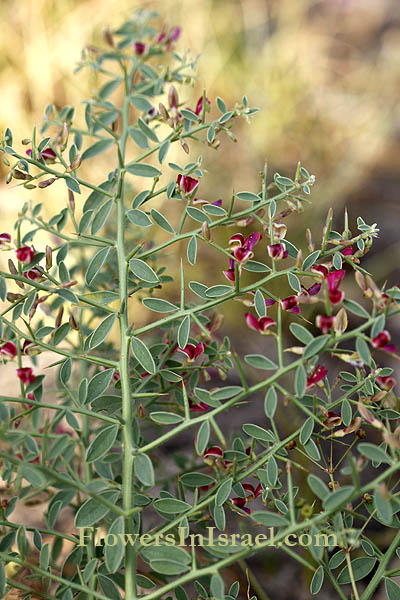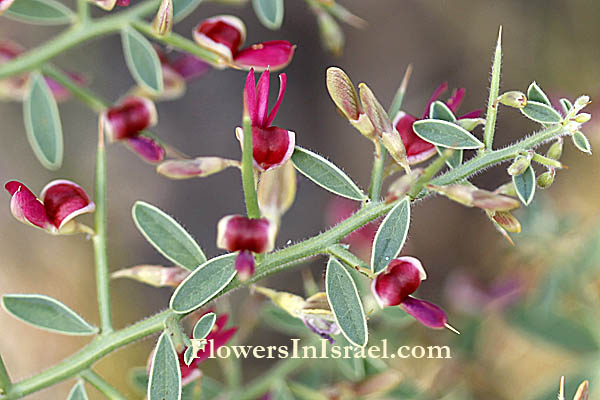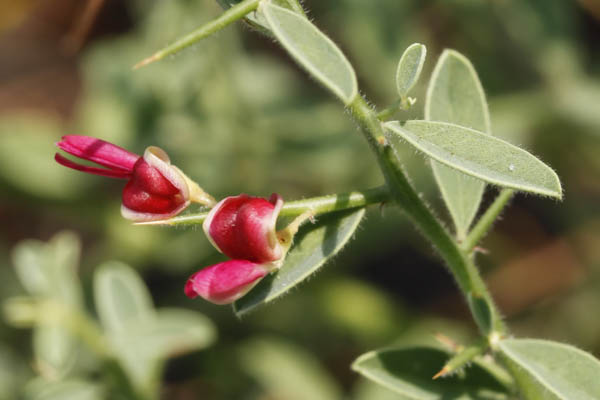Hebrew: הגה מצויה, Arabic: العاقول الإغريقي, Egypt: عقول " 'Aqoul"
| Scientific name: | Alhagi graecorum Boiss. | |
| Synonym name: | Alhagi maurorum Medicus | |
| Common name: | Camelgrass, Camel's thorn, Persian Manna Plant | |
| Hebrew name: | הגה מצויה | |
| Arabic name: | عاقول, العاقول الإغريقي "Al-Agool," | |
| Egypt: | عقول " 'Aqoul" | |
| Family: | Papilionaceae, פרפרניים |

|
| Life form: | Hemicryptophyte | |
| Spinescence: | Stems | |
| Stems: | Up to 80cm high, woody at the base in old specimens, glabrous or sparingly hairy, with long creeping stolons; stems erect or ascending, much branched, twigs spiny at their tips | |
| Leaves: | Alternate, entire, oblong-elliptic or obovate, sessile or short-petioled | |
| Inflorescence: | Flowers axillary or on spiny twigs, short-pedicelled | |
| Flowers: | Calyx 3-4mm long, with short teeth; corolla pink (dark), violet, 10-12mm long; ovary silky-hairy | |
| Fruits / pods: | Indehiscent pod, 1-3.5cm long, 3-8-seeded, cylindrical, curved, constricted between the seeds; seeds reniform, brownish, smooth | |
| Flowering Period: | April, May, June, July, August, September | |
| Habitat: | Salty habitats, Disturbed habitats | |
| Distribution: | Mediterranean Woodlands and Shrublands, Semi-steppe shrublands, Shrub-steppes, Deserts and extreme deserts | |
| Chorotype: | Med - Irano-Turanian | |
| Summer shedding: | Perennating |

Derivation of the botanical name: Alha'gi from Arabic "Al-Haggi, for "the pilgrim". graecorum, of Greek origin. The Hebrew word: הגה, hyga related to Jewish Aramaic הֵיגָא, הֵיגֽתָא, Arab. ḥāj (= the camel’s thorn). From the Semitic base ḥ-y-g, ḥ-w-g (= to surround, hedge, fence in) ‘thorns forming a hedge’.
Alhagi manna (Persian and Arabic tar-angubin, also known as terendschabin and Taranjabiti, Taranjabiti) is the produce of Alhagi maurorum. This manna occurs in the form of small, roundish, hard, dry tears, varying from the size of a mustard seed to that of a coriander, of a lightbrown colour, sweet taste, and senna-like odour. The spines and pods of the plant are often mixed with it. Tamarisk manna (Persian gaz-angubin, tamarisk honey) exudes in June and July from the slender branches of Tamarix gallica, var. mannifera, in the form of honey-like drops, which, in the cold temperature of the early morning, are found in the solid state. This secretion is caused by the puncture of an insect, Coccus manniparus. The manna of the Biblical narrative, notwithstanding the miraculous circumstances which distinguish it from anything now known, answers in its description very closely to the tamarisk manna. See the list of Medicinal herbs in Israel, the parts used and their medical uses to treat various diseases 


|